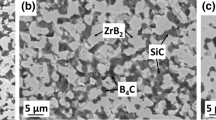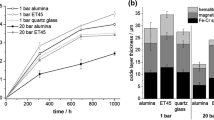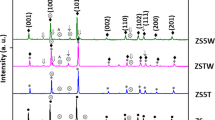Abstract
For the purpose of investigating ultra-high temperature oxidation, a novel induction heating facility has been established. The oxidation kinetics of several typical ultra-high temperature materials (UHTMs), including two graphite-based composites (C/C and ZrB2/C) and two ternary Zr-Al-C ceramics (Zr2Al3C4 and Zr2[Al(Si)]4C5), were tested by utilizing this facility. It has been identified that the tested cylindrical samples with dimensions of Φ 20 mm × 20 mm can be oxidized uniformly. The maximum temperature of 2450°C can be achieved on graphite-based composites, and the oxygen partial pressure can be controlled in the range of 102–105 Pa. This novel technique exhibits many advantages, such as an extremely high heating rate of about 20°C/s, easy controlling of temperature and gas pressure, low energy consumption, low cost, and high efficiency. Therefore, it provides a potential way for profoundly investigating the ultra-high temperature oxidation behaviors of UHTMs.
Similar content being viewed by others
References
Manocha L M. High performance carbon-carbon composites. Sadhana, 2003, 28(1–2): 349–358
Gasch M, Ellerby D, Irby E, et al. Processing, properties and arc jet oxidation of hafnium diboride/silicon carbide ultra high temperature ceramics. Journal of Materials Science, 2004, 39(19): 5925–5937
Fujii K. Progress and future prospects of CFD in aerospace—Wind tunnel and beyond. Progress in Aerospace Sciences, 2005, 41(6): 455–470
Tang S, Deng J, Wang S, et al. Ablation behaviors of ultra-high temperature ceramic composites. Materials Science and Engineering A, 2007, 465(1–2): 1–7
Zhou S, Li W, Hu P, et al. Ablation behavior of ZrB2-SiC-ZrO2 ceramic composites by means of the oxyacetylene torch. Corrosion Science, 2009, 51(9): 2071–2079
Han J, Hu P, Zhang X, et al. Oxidation-resistant ZrB2-SiC composites at 2200°C. Composites Science and Technology, 2008, 68(3–4): 799–806
Buckley J D. Carbon-carbon, an overview. American Ceramic Society Bulletin, 1988, 67(2): 364–368
Mckee D W. Effect of adsorbed phosphorus oxychloride on the oxidation behavior of graphite. Carbon, 1972, 10(4): 491–497
Lachaud J, Aspa Y, Vignoles G L. Analytical modeling of the steady state ablation of a 3D C/C composite. International Journal of Heat and Mass Transfer, 2008, 51(9–10): 2614–2627
Han J C, He X D, Du S Y. Oxidation and ablation of 3D carboncarbon composite at up to 3000°C. Carbon, 1995, 33(4): 473–478
Guo W, Xiao H, Yasuda E, et al. Oxidation kinetics and mechanisms of a 2D-C/C composite. Carbon, 2006, 44(15): 3269–3276
Khalil K A, Kim S W. Mechanical wet-milling and subsequent consolidation of ultra-fine Al2O3-(ZrO2+ 3%Y2O3) bioceramics by using high-frequency induction heat sintering. Transactions of Nonferrous Metals Society of China, 2007, 17(1): 21–26
Codrington J, Nguyen P, Ho S Y, et al. Induction heating apparatus for high temperature testing of thermo-mechanical properties. Applied Thermal Engineering, 2009, 29(14–15): 2783–2789
He L F, Lin Z J, Wang J Y, et al. Synthesis and characterization of bulk Zr2Al3C4 ceramic. Journal of the American Ceramic Society, 2007, 90(11): 3687–3689
He L F, Bao Y W, Li M S, et al. Oxidation of Zr2[Al(Si)]4C5 and Zr3[Al(Si)]4C6 in air. Journal of Materials Research, 2008, 23(12): 3339–3346
Tong Q, Shi J, Song Y, et al. Resistance to ablation of pitch-derived ZrC/C composites. Carbon, 2004, 42(12–13): 2495–2500
Author information
Authors and Affiliations
Corresponding author
Rights and permissions
About this article
Cite this article
Xu, JJ., Li, MS., Fang, XL. et al. A novel ultra-high temperature oxidation technique in flowing gas with controlled oxygen partial pressure. Front. Mater. Sci. China 4, 266–270 (2010). https://doi.org/10.1007/s11706-010-0086-0
Received:
Accepted:
Published:
Issue Date:
DOI: https://doi.org/10.1007/s11706-010-0086-0




